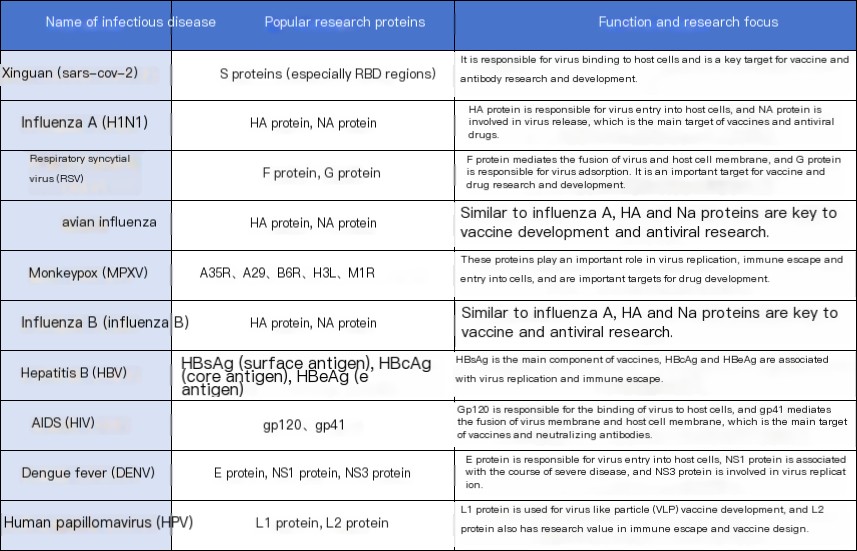Infectious Disease Antigen and Antibody Raw Materials: Facilitating Diagnostics and Vaccine Development

Recent Advances
Infectious disease research constitutes a critical component of global public health. With the acceleration of globalization, the transmission speed and scope of infectious diseases have expanded significantly, drawing widespread attention to several high-profile infectious diseases.
The outbreak of the COVID-19 pandemic has underscored the urgency of infectious disease research, with key focuses including virus tracing, transmission mechanism elucidation, and vaccine and drug development. Beyond COVID-19, other notable infectious diseases include monkeypox, dengue fever, and human papillomavirus (HPV). Research on monkeypox centers on critical viral targets such as the A35R and A29 proteins, which play essential roles in viral replication and immune evasion. Dengue fever research focuses on the E and NS1 proteins, which are closely associated with viral infection mechanisms and severe disease progression. HPV research emphasizes the L1 protein, a key component in the development of virus-like particle (VLP) vaccines. Below is a summary of recent pandemic infectious diseases and their major research proteins and functions.

Approaches to Infectious Disease Vaccine Research
Vaccines, as a core strategy for preventing infectious diseases, have transformed the landscape of humanity's battle against these diseases. They not only effectively prevent disease transmission but also significantly reduce morbidity and mortality rates.
Research strategies and priorities for vaccines vary depending on the characteristics of the pathogen. Broad-spectrum vaccines focus on leveraging conserved antigenic regions, subunit vaccines emphasize antigen purification and structural optimization, nanoparticle vaccines enhance immunogenicity through nanotechnology, and peptide-based vaccines concentrate on presenting key epitopes. These strategies offer diverse solutions for the prevention and control of infectious diseases.
Broad-Spectrum Vaccines
Broad-spectrum vaccines aim to provide extensive protection against multiple pathogens or their variants. Research focuses on identifying and utilizing conserved antigenic regions to induce broad-spectrum neutralizing antibodies and immune responses.
Example 1: COVID-19 Vaccine
-
Research Approach: Target the receptor-binding domain (RBD) of the SARS-CoV-2 spike (S) protein, as the RBD is critical for virus-host cell binding and relatively conserved.
-
Application: Design stable S protein trimers (e.g., S-Trimer) or RBD dimers combined with adjuvants (e.g., AS03 or CpG 1018 + aluminum adjuvant) to induce high levels of neutralizing antibodies and cellular immune responses.
Example 2: Influenza Vaccine
-
Research Approach: Develop vaccines targeting conserved regions of the influenza virus hemagglutinin (HA) protein to provide broad protection against multiple influenza strains.
-
Application: Use recombinant protein or mRNA technology to design vaccines covering multiple influenza strains, reducing the limitations of seasonal influenza vaccines.
Subunit Vaccines
Subunit vaccines use specific proteins or protein fragments of pathogens as antigens, avoiding risks associated with using whole pathogens while inducing targeted immune responses.
Example 1: COVID-19 Subunit Vaccine
-
Research Approach: Utilize the RBD or full-length S protein as antigens, with structural optimization (e.g., proline stabilization of the RBD "up" conformation) to enhance immunogenicity.
-
Application: For example, Novavax's NVX-CoV2373 vaccine employs a stable S protein trimer combined with Matrix-M adjuvant to induce high-titer neutralizing antibodies and multifunctional T-cell responses.
Example 2: Hepatitis B Vaccine
-
Research Approach: Use hepatitis B surface antigen (HBsAg) as the primary antigen, produced through genetic engineering.
-
Application: For instance, the Heplisav vaccine, combined with a TLR9 agonist adjuvant, enhances immune responses and improves vaccine efficacy.
Example 3: HPV Vaccine
-
Research Approach: Design virus-like particles (VLPs) using the major capsid protein L1 of HPV as the primary vaccine component.
-
Application: VLP vaccines induce strong neutralizing antibody responses, preventing HPV infection without infectious risks.
Nanoparticle Vaccines
Nanoparticle vaccines enhance antigen stability and immunogenicity by immobilizing antigens on nanoparticle surfaces.
Example 1: COVID-19 Nanoparticle Vaccine
-
Research Approach: Use ferritin nanoparticles as scaffolds to immobilize the RBD or its fragments on the nanoparticle surface.
-
Application: For example, S-Fer and SΔC-Fer nanoparticle vaccines, optimized through molecular dynamics simulations, significantly increase neutralizing antibody titers.
Peptide-Based Vaccines
Peptide-based vaccines utilize key epitopes of pathogens to induce specific immune responses, suitable for pathogens that are difficult to culture or highly variable.
Example 1: HCV Vaccine
-
Research Approach: Use peptide mixtures from the HCV nonstructural protein 3 (NS3), covering key T-cell epitopes.
-
Application: Immunization in mice demonstrates significant enhancement of CD4+ and CD8+ T-cell responses.
Infectious Disease Antigens & Antibody Raw Materials
START provides a wide range of infectious disease antigens and antibody raw materials, including those for COVID-19, influenza A, respiratory syncytial virus (RSV), avian influenza, monkeypox, influenza B, hepatitis B, HIV, dengue fever, and HPV.




